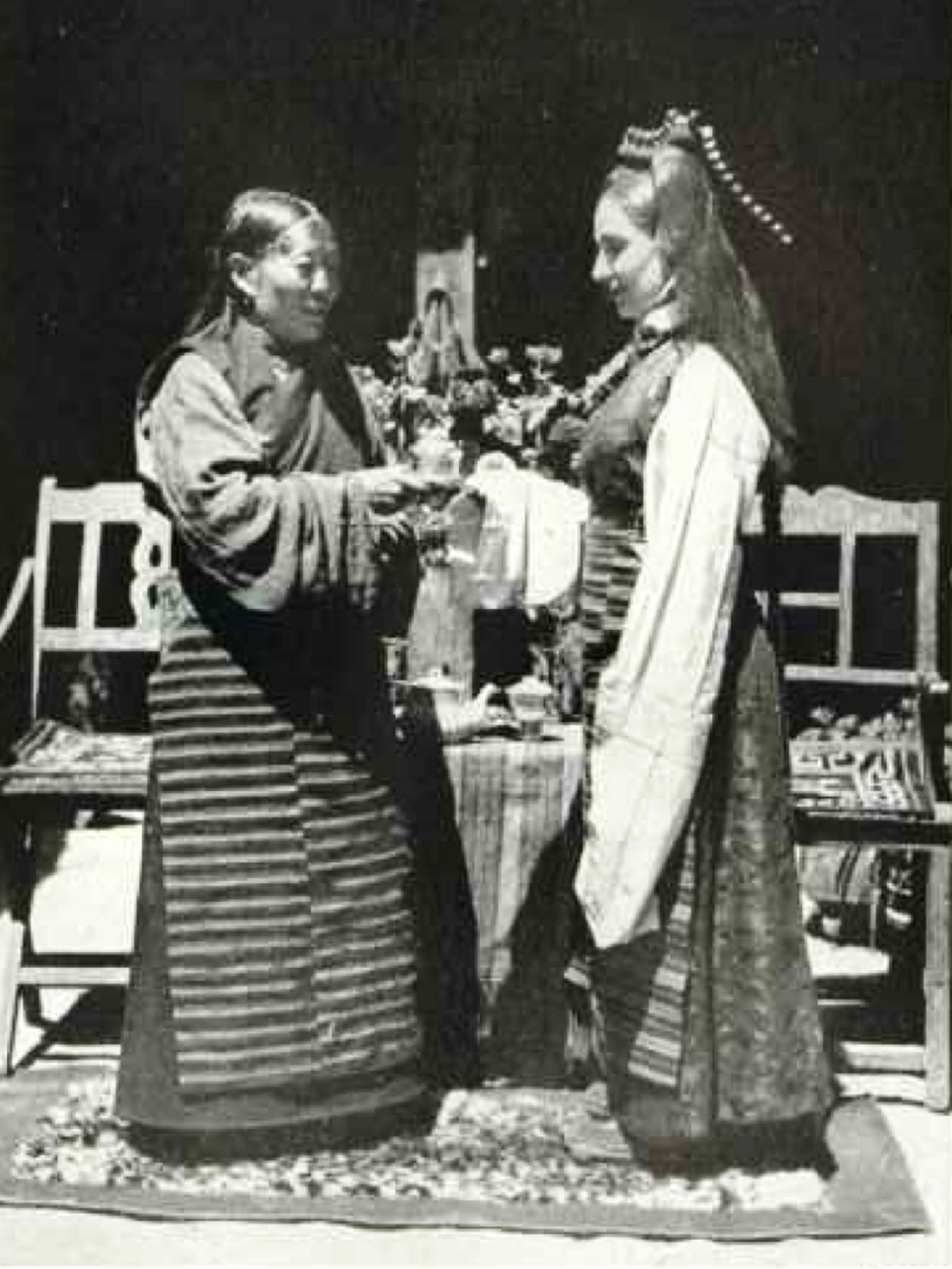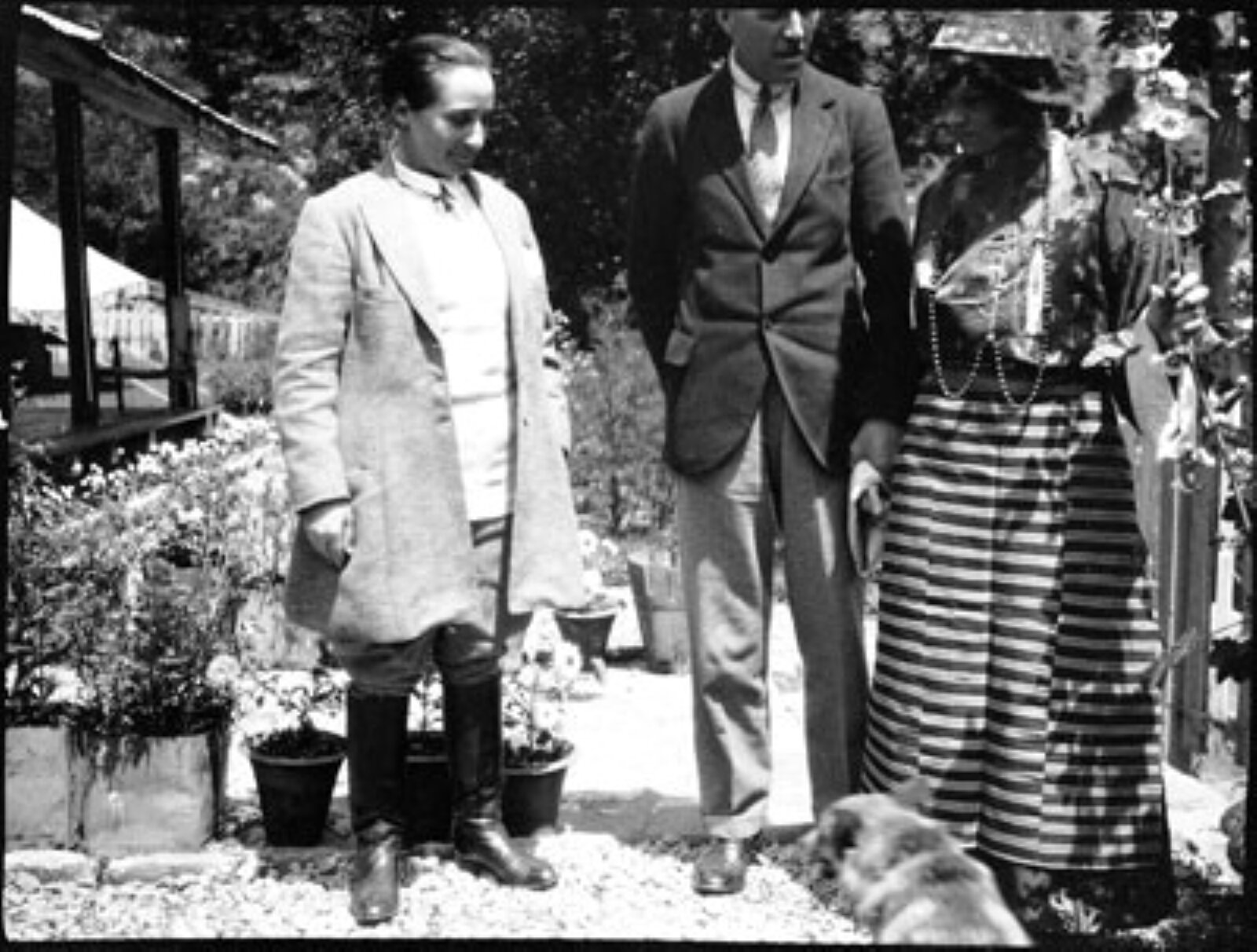Léa Lafugie

Léa Lafugie (11 Feb 1890, Paris 7 — 18 June 1972, Paris 16) was a French explorer, artist and writer, one of the first solo traveler women to sojourn in Tibet, and whose body of work reflects her lasting interest in China and Southeast Asia.
After studying at Paris Ecole des Arts decoratifs (School of Decorative Arts), at Ecole des Beaux-Arts (School of Fine Arts) and Academie Jullian, she started working in fashion illustration, with nude paintings, engravings of hairstyles and portraits of young women displaying the new feminism of the “Roaring Twenties”.
As soon as 1924, Léa Lafugie embraced the vocation of “painter-traveler”, wandering through North Africa and holding her first exhibition in Tunis. Inspired by travel writer Alexandra David-Néel (who was to be nicknamed “the Parisian Lady in Lhasa”), she headed for Burma (now Myanmar) and Tibet, where she stayed in three occasions: 1926 (Kashmir and Ladakh), 1927 (Darjeeling, Sikkim and Tibet up to Gyantse), and 1931 (Shimla, Spiti Valley, Ladakh, Srinagar). While drawing and painting without a pause, she published her travel notes in renowned outlets, from L’Illustration to Extreme-Asie to the National Geographic, and wrote two books, displaying a noted talent for ethnographical observations in addition to her art.
In 1932, she married in Paris Claude-Prosper-André Décamps, the owner of teak plantations in Thailand and Malaysia. By then, she had already visited Shanghai, Siam, Sri Lanka, India, Vietnam, Cambodia, Laos, Indonesia, Japan, “managing to alternate long periods of solitary exploration in territories where no European had penetrated and luxurious stays in local aristocratic families or Western diplomatic circles, with the “policy” of being accepted everywhere by offering their portrait to her hosts, seized with curiosity and enchanted by her artistic talent as well as by her open-mindedness and her understanding of situations,” according to her profile on Far Orientalism.
A prolific artist, she held in December 1927 an exhibition at the School of Fine Arts of Calcutta with no less than 280 works. She portrayed Tibetan monks, opium users in China — with notations pointing to the fact that she tried it more than once -, Cambodian, Javanese and Burmese dancers, and was also so well-connected that she could paint a portrait of Mahatma Gandhi, Rabindranath Tagore - who had been portrayed by French female Andree Karpeles (Suzanne Karpeles’ sister) in 1913 -, or King Sisowath Monivong in Phnom Penh. She was known as Madame Lafugie, and before her marriage as Mademoiselle Lafugie. A talented photographer, she often took photos of her subjects to document future paintings. As she recounted in her book Tibet, terre des buddha vivants (1963),
“Fluent in English, fond of history and local civilizations, endowed with a strong personality and her asserted femininity, she attended in June 1929 the ceremonies of the burial of the coffin of Sun Yat Sen at the Mausoleum of the Purple Mountain (she recounts this event in L’Illustration of June 29, 1929). At the request of his widow, Song Qinglin, she made a posthumous portrait of the famous creator of the Chinese Republic. From September to December, she visited Japan and had the exceptional privilege of producing portraits of Emperor Hiro Hito and Impress Kojun. In January 1930, she decided to head back to France, passing through Honolulu, Tahiti, San Francisco, New York to arrive in Paris in April.” [Far Orientalism, op.cit.] She was on the road again in September 1930, this time for the Dutch Indies, painting portraits of Javanese sultans, staying with the Dayak tribes of Borneo, then in Celebes and Bali, and exhibiting in Surabaya. Her exhibition “Java, Bali, Borneo” was shown at Paris Galerie Charpentier in 1932. After her third trip to Tibet, she returned to France via Iran, Iraq, Syria, and Lebanon to in July 1932.
When Lafugie and Decamps settled in northern Thailand (Chiang Rai), she pursued her work on Southeast Asia, with exhibitions in Saigon, Hanoi, Singapore and Bangkok. Imprisoned by the Japanese occupation troops in March 1945, they were repatried to France only in May 1946. From then, she traveled less, staying in Colombo between 1951 and 1955 — Decamps was there conducting a mission for the United Nations –, gave conferences and exhibitions in various cities — Washington and New York in 1948 –, and published her two books on Tibet, in 1950 and 1963.
Presenting her travelogue “Comment j’ai parcouru le Tibet” [How I roamed Tibet] in 1928, she wrote that it was just “le simple carnet de route d’une artiste qui né peut révéler au monde ni les aventures d’une expédition romanesque ni les spéculations philosophiques d’un savant anthropologiste. Je né suis ni savant, ni romancier, ni ethnologue. Je suis peintre, plus curieuse d’impressions visuelles que de notations verbales, de couleurs que de mots.” […“the simple travel diary of an artist who cannot reveal to the world either the adventures of a romantic expedition or the philosophical speculations of a learned anthropologist. I am neither a scholar, nor a novelist, nor an ethnologist. I am a painter, more curious about visual impressions than verbal notations, about colors than words.”]
In spite of her sincere self-effacement, Lea Lafugie has been equalled to the greatest French female explorers: “Exploratrices… On pense à Alexandra David-Neel parvenant Lhassa, la ville interdite, consacrant quarante années de Tibet, ramenant de ses périlleux voyages non seulement des recits mais des textes tibétains, une grammaire, un dictionnaire, études sur le bouddhisme. A madame Lafugie s’attachant le secret des lamaseries dans le Thibet oriental ; à Ella Maillart allant de Pékin à Srinagar ; à Louise Weiss qui nous fit découvrir au Cachemire et en Chine une humanité troublée, frémissante. Gabrielle Bertrand, elle aussi, appartient à l’Asie : Mongolie. Mandchourie, Chine du Nord et Assam.” [“Women explorers…we think of Alexandra David-Neel arriving in Lhasa, the forbidden city, spending forty years in Tibet, bringing back from her perilous journeys not only her accounts but also Tibetan texts, a grammar, a dictionary, studies on Buddhism; of Madame Lafugie embracing the secrets of the lamaseries in eastern Tibet; to Ella Maillart going from Beijing to Srinagar; of Louise Weiss who introduced us to a troubled, quivering humanity in Kashmir and China. Gabrielle Bertrand, too, belongs to Asia: Mongolia. Manchuria, North China and Assam.”] [cf. Christine Garnier, “Comment reussissent les femmes, VII: Gabrielle Bertrand, De l’Empire du Milieu aux “Pays barbares”, Revue des Deux Mondes, 1st April 1961, pp. 484 – 491.]
Her numerous body of work has been dispersed, reappearing only during auctions. It was only in 2012 – 2013 that four of her drawings and watercolors were exhibited at the Cernuschi Museum in Paris (“Du Fleuve Rouge au Mékong”). Ten years later, her legacy was celebrated at the group exhibition “Artistes voyageuses: L’appel des lointains 1880 – 1944” (11 Dec. 2022 – 21 May 2023) at Palais Lumiere, Evian, France.
Curiously, although she is said to have painted several views of Angkor temples, Lea Lafugie is less remembered in Cambodia than in Indonesia, where Duta Fine Arts Foundation showcased more than 80 of her paintings during the 2016 exhibition ‘The French Artist, La Lafugie in Indonesia’. Didiel Hamel, the curator, published on that occasion the first major work on the life and works of the artist. And in Vietnam, the blog ĐỂ GIÓ CUỐN ĐI (Gone with the Wind) listed four artworks by Lafugie in 2020.
Publications
- “Comment j’ai parcouru le Tibet, Notes et impressions de voyage d’une artiste peintre”, Extreme-Asie, n.28 – 30, 1st October 1928, pp 197 – 242.
- [9 illustrations in] Maurice Larrouy, “Pékin, ville évoluée et archaïque”, L’Illustration, n 4630, 28 Nov 1931.
- “A Woman Paints the Tibetans” (signed “Lafugie”), National Geographic vol. XCV‑5, 1949, pp 658 – 92.
- [recension of Lea Lafugie’s Paris exhibition] Agnès Bau, “Visions d’Outremer à Paris”, France Outremer n 238, June 1949.
- Au Tibet, par Léa Lafugie, J. Susse, Paris, 1950 (preface by Alexandra David-Néel).
- Series on elephants, with 15 illustrations, in Naturalia-Bêtes et Plantes, Fev. (n 77), March (n 78) , Apr. (n 79) 1960.
- Le Tibet, terre des Bouddha vivants, par Léa Lafugie, société continentale d’éditions modernes illustrées, Paris, 1963
- Léa Lafugie, art et aventure, by Didier Hamel et Sandrine Dapsens, Hexart Publishing, Jakarta, 2016. ISBN: 9786029166316



